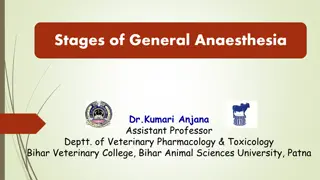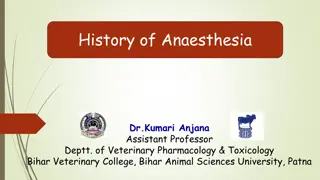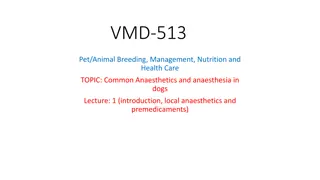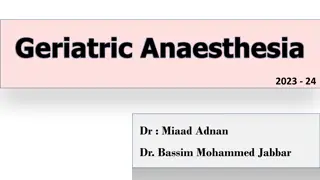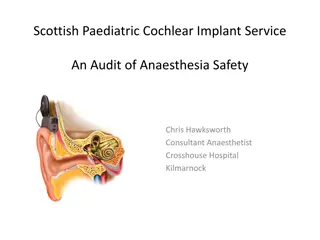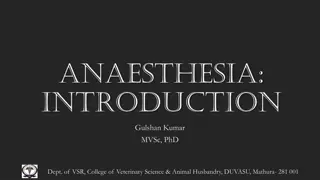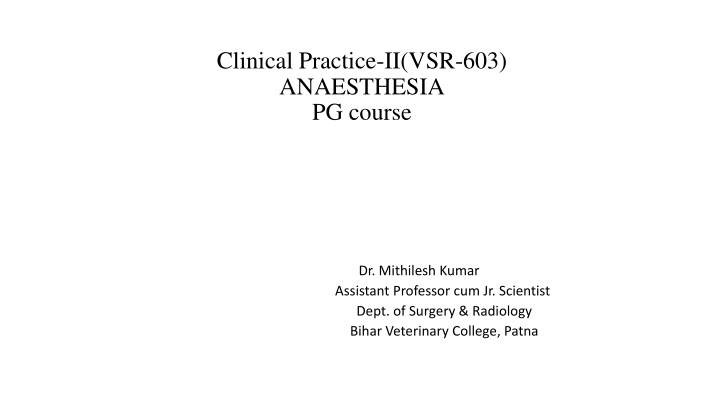
Veterinary Anaesthesia: Techniques, Agents, and Considerations
Learn about the different types of anaesthesia used in veterinary practice, including local, regional, general anaesthesia, and more. Discover the selection criteria for anaesthetic agents based on factors such as surgical procedure time, animal metabolism, age, and breed. Understand the importance of choosing the right anaesthetic based on species differences and the physical health of the animal. Explore the availability of equipment and personnel required for successful anaesthesia administration in veterinary surgery.
Download Presentation

Please find below an Image/Link to download the presentation.
The content on the website is provided AS IS for your information and personal use only. It may not be sold, licensed, or shared on other websites without obtaining consent from the author. If you encounter any issues during the download, it is possible that the publisher has removed the file from their server.
You are allowed to download the files provided on this website for personal or commercial use, subject to the condition that they are used lawfully. All files are the property of their respective owners.
The content on the website is provided AS IS for your information and personal use only. It may not be sold, licensed, or shared on other websites without obtaining consent from the author.
E N D
Presentation Transcript
Clinical Practice-II(VSR-603) ANAESTHESIA PG course Dr. Mithilesh Kumar Assistant Professor cum Jr. Scientist Dept. of Surgery & Radiology Bihar Veterinary College, Patna
Anaesthesia Local Anaesthesia Regional Anaesthesia General Anaesthesia Surgical Anaesthesia : Unconsciousness where adequate muscular relaxation produced.
Analgesia :- Loss of pain Tranquilisation : Behavioural change in which patient is relaxed but unconcerned with surrounding. Sedation : Mild central depression when patient is awake but calm. Narcosis : Deep sleep accompanied by analgesia. Hypnosis: artificially induced sleep and results from moderate depression of CNS.
Anaesthetic agent : Produces both unconsciousness and absence of response. Analgesic agent :- Temporarily abolishes awareness of pain. Narcotic : Produce insensibility from which simple stimuli can achieve. Hypnotic : used to induce sleep. Sedative : used to calm a nervous, excited animal. Tranquiliser :- Produce sedation.
Selection of anaesthetic agent depends on : Time required to perform a surgical procedure : Ultra short acting and Inhalant anaesthetic agent. The metabolic rate of an animal : Young animal has low metabolism. Age of the animal : Aged animals are poor anaesthetic risk. Breed : Brachycephalic having pendulous soft palate and restricted respiratory passage.
Species differences : Regional anaesthesia desirable in cattle, buffalo and goat. Type Surgery /Surgeon : Barbiturate are contraindicated for CS. Positive pressure surgery used for thorax. Physical state or health of animal: patients with no detectable disease can be given barbiturate, non barbiturate or inhalation agent Systemic disease like uraemia, toxaemia may have altered hepatic and kidney function, Inhalation agents preferred.
Availability of equipment's and personnel:- Qualified anaesthetist. Art of anaesthesia.
Local Anaesthetic Agents:- Cocaine hydrochloride- Surface anaesthesia for cornea and Conjunctiva Procaine hydrochloride-Non irritant and non toxic. Poor mucouos membrane penetration. Butacaine- Surface anaesthesia for eye, nose and throat
Amethocaine:- 1% solution is used for instillation into eye. Tetracaine:- Drug of choice for corneal anaesthesia Lignocaine hydrochloride :-Surface and injectable anaesthetic Tutocaine hydrochloride:- Derivative of procaine, Infiltration anaesthesia
Mepivacaine hydrochloride:- Similar to lignocaine. Bupivacaine hydrochloride (Morcain):- 0.5%solution is equivalent to 2% Lignocaine. Ethyl chloride:- Surface anaesthesia - removes heat and freezes the area.





